COVID-19 Paid Sick Leave (SPSL) Extended Through End of the Year
As anticipated from last week’s newsletter, on September 29, 2022, Governor Gavin Newsom signed AB 152 into law. AB 152 is a budget trailer bill extending an employee’s eligibility to use 2022 COVID-19 Supplemental Paid Sick Leave (SPSL) through December 31, 2022. SPSL applies to employers with 26 or more employees.
Update (October 3): The California Division of Labor Standards Enforcement (DLSE) has updated the SPSL poster to reflect the new expiration date. Employers should replace their existing posters with this version and may send the poster via email to employees who are completely remote.
When California initially enacted the 2022 COVID-19 SPSL program, employees were provided up to 40 hours of paid sick leave for the following seven qualifying reasons:
- The employee is subject to a quarantine or isolation period related to COVID-19 as defined by an order or guidance from the State Department of Public Health, the federal Centers for Disease Control and Prevention, or a local public health officer who has jurisdiction over the workplace.
- The employee has been advised by a health care provider to isolate or quarantine due to COVID-19.
- The employee is experiencing symptoms of COVID-19 and seeking a medical diagnosis.
- The employee is caring for a family member who’s subject to a government quarantine, isolation order or guidance; or who has been advised by a health care provider to isolate or quarantine.
- The covered employee is caring for a child, as defined in subdivision (c) of Section 245.5, whose school or place of care is closed or otherwise unavailable for reasons related to COVID-19 on the premises.
- The employee is attending an appointment for themselves or a family member to receive a vaccine or a vaccine booster for protection against COVID-19.
- The employee is experiencing symptoms, or caring for a family member experiencing symptoms, related to a COVID-19 vaccine or vaccine booster that prevent the employee from working or teleworking.
In addition, an employee could receive up to 40 additional hours of paid sick leave if their qualifying reason for leave related to the employee or a qualifying family member contracting COVID-19. SPSL was originally set to expire on September 30, 2022.
Although AB 152 does extend the availability of SPSL through December 31, 2022, it doesn’t increase an employee’s leave entitlement. This means that if an employee has already used all their SPSL hours earlier this year, they don’t receive any additional hours. The California DLSE keeps an updated guidance resource for employers with further FAQs about administering SPSL.
Fortunately, California small businesses have some good news because AB 152 establishes a grant program to allow small businesses to recover up to $50,000 paid out in SPSL benefits over the course of the year. The grant program will be administered through the Office of the Small Business Advocate (OSBA) within the Governor’s Office of Business and Economic Development (GO-Biz). Although GO-Biz and OSBA have not yet established the application process, AB 152 does establish criteria that can help small businesses prepare to apply as soon as the application period is open.
The grant is available to qualifying small businesses and non-profits. To qualify, the organization must:
- Be a “C” corporation, “S” corporation, cooperative, limited liability company, partnership, limited partnership, registered 501(c)(3), 501(c)(6) or 501 (c)(19);
- Have begun operating before June 1, 2021;
- Be currently active and operating;
- Have 26 to 49 employees and provide payroll data and an affidavit signed under the penalty of perjury attesting to the number of employees;
- Have provided SPSL pursuant to the requirements of the law; and
- Provide organizing documents including 2020 or 2021 tax returns or Form 990s, official filings with the Secretary of State of local municipalities such as Articles of Incorporation, Certificate of Organization, Fictitious Name of Registration, or Government-Issued Business License.
Some organizations that do meet the criteria above are excluded from the grant program. The exclusion includes organizations without a physical presence in the state, engaged primarily in political or lobbying activities, and financial institutions that primarily lend money.
While GO-BIZ and OSBA prepare to get the program up and running, employers that do meet the above criteria can begin to collect the information required to help expedite the process and take advantage of this grant program.
Show Me the Money: California Enacts New Pay Disclosure Requirements
Pay transparency laws have gathered steam across the country. California follows Colorado, Connecticut, Maryland, Nevada, Rhode Island, Washington, New York City, Cincinnati, and Toledo, among other jurisdictions, in enacting legislation to require employers to disclose wage information to job applicants, and in some instances, to current employees. Advocates of the new law assert that it will help drive pay equity across genders and nationalities. After intense floor hearings in the state assembly and senate, and five major amendments, on September 27, 2022, Governor Newsom signed Senate Bill 1162, which goes into effect on January 1, 2023.
This sweeping new law imposes two significant requirements on covered employers: job-posting requirements and pay data disclosures. The law requires employers with 15 or more employees to include a pay scale in job postings starting January 1, 2023. Companies with 100 or more employees must report to the state the pay data of their employees and contractors by race, ethnicity and gender.
Pay Scale Disclosures
Job postings. Both private and public employers must follow the new wage disclosure requirements for job postings. This requirement is meant to address wage disparities at the beginning of employment. Newly revised Labor Code section 432.3 applies to employers with 15 or more employees. Covered employers are required to include a pay scale for the job opening being advertised. This includes third-party postings used by employers. The pay scale must be given to the third party so they can include it in their job advertisement for the employer. The law does not address whether nationwide job postings must comply if the opening could be filled by someone in California.
The definition of pay scale in this law is broad and open to interpretation. Pay scale is defined as the salary or hourly wage range that the employer reasonably expects to pay for the position. It is unclear whether this includes bonuses, commissions, health benefits or paid time off. Those variable factors could make a big difference in the amount disclosed.
Pay scale requests. All covered employers must now provide current employees with a pay scale for their position upon request. Many employers will see an onslaught of requests from current employees after the new year, so employers should prepare now for those conversations.
A portion of existing law was quietly stricken as a result of this bill. Prior to enactment of SB1162, applicants for employment were already entitled to request the pay for an open position, but only if they had completed an initial interview with the employer. Now any applicant is entitled to this information upon reasonable request, without having to interview. An applicant is defined as someone who is “seeking employment with the employer and is not currently employed with that employer in any capacity or position.” The law does not differentiate between job seekers in general and someone who has submitted an application.
Record retention. Under the law, employers must abide by new record retention requirements. Covered employers must maintain a record of each employee’s job title and wage history during their employment period and for three years thereafter. These records must be made available to the Labor Commissioner for inspection to determine if there is a pattern of wage discrepancy. An employer’s failure to keep these records creates a rebuttable presumption in favor of an employee’s claim. This is a burdensome recordkeeping requirement and imposes an obligation to save records well beyond any current record retention schedule. As a result, employers should plan how to save older records before they are purged and revise any existing retention schedules to comply with SB 1162.
Enforcement. The law establishes a new private right of action for injunctive and other relief. There are also civil penalties for violations of this statute. A person can file a written complaint with the Labor Commissioner within one year from the date they learned of the violation (not when the violation may have occurred.) Technical violations of the new pay scale requirements could lead to penalties up to $10,000 per violation. The first penalty will not be assessed if the employer has demonstrated they have cured the job posting violation by updating it to include the pay scale.
Annual Pay Data Report
This new law significantly amends the Annual Pay Data Report requirements. Private employers with 100 or more employees must file an annual report with the Civil Rights Department that discloses certain pay data according to race, ethnicity, and gender within each of the following job categories:
- Executive- or senior-level officials and managers
- First- or mid-level officials and managers
- Professionals
- Technicians
- Sales Workers
- Administrative support workers
- Craft workers
- Operatives
- Laborers and helpers
- Service workers
The following information must be disclosed in the Annual Pay Data Report:
- The number of employees by race, ethnicity, and gender in the above 10 categories;
- Within each of the above job categories, for each combination of race, ethnicity and gender, the mean and median hourly rate (using W-2s);
- The number of employees by race, ethnicity, and gender whose annual earnings fall within each of the pay bands used by the U.S. Bureau of Labor Statistics in the Occupational Employment Statistics Survey (using W-2s);
- The total number of hours worked by each employee counted in each pay band during the reporting year; and
- For covered employers with multiple establishments, there must be a separate report with this pay data, above, which covers each establishment.
Staffing companies are included. Private employers with 100 or more employees hired through labor contractors in the prior calendar year must submit a separate pay data report covering labor contractors. The law defines a labor contractor as “an individual or entity that supplies, either with or without a contract, a client employer with workers to perform labor within the client employer’s usual course of business.” The legislature included staffing companies and labor contractors in this bill under the assumption that use of contractors is on the rise, and that contract workers provide the same services as directly hired employees but are paid less. As a result, SB1162 also requires the gathering and reporting of data for this category of workers.
Covered employers must now disclose the ownership names of all labor contractors used to supply workers. Only one sentence in the law addresses this requirement: “A labor contractor shall supply all necessary pay data to the private employer.” If an employer is unable to submit a “complete and accurate report” because the staffing company failed to provide its pay data to the employer, the Civil Rights Department may ask a court to apportion an appropriate portion of penalties against the labor contractor.
Filing Deadline. The first report is due May 10, 2023, and annually thereafter on the second Wednesday in May. The Department must be able to review and sort the categories of information provided. Employers must upload their data files using the California Pay Data Reporting Portal.
Penalties May Be Imposed and Costs Recovered. Failure to file the report can lead to civil penalties of $100 per employee for the first offense and $200 per employee for subsequent violations. For an employer with 100 employees, that could amount to a $10,000 fine. Larger corporations with several hundred employees in multiple establishments are looking at far more significant fines. The law authorizes the Department to recover the costs of compelling an employer to comply with the reporting requirements.
Enforcement. The law also authorizes the Civil Rights Department to request the Employment Development Department to provide it with the names and addresses of all businesses with 100 or more employees to ensure each complies with the report filing requirements. This list, while meant for auditing purposes, will be a public record. We anticipate that the Civil Rights Department will enact regulations in the next year with further details of disclosure and compliance obligations.
California public and private employers should begin preparing now for these significant new legal requirements.
Sources: COVID-19 Paid Sick Leave (SPSL) Extended Through End of the Year: https://hrwatchdog.calchamber.com/2022/09/covid-19-paid-sick-leave-spsl-extended-through-end-of-the-year/
Show Me the Money: California Enacts New Pay Disclosure Requirements: https://www.littler.com/publication-press/publication/show-me-money-california-enacts-new-pay-disclosure-requirements

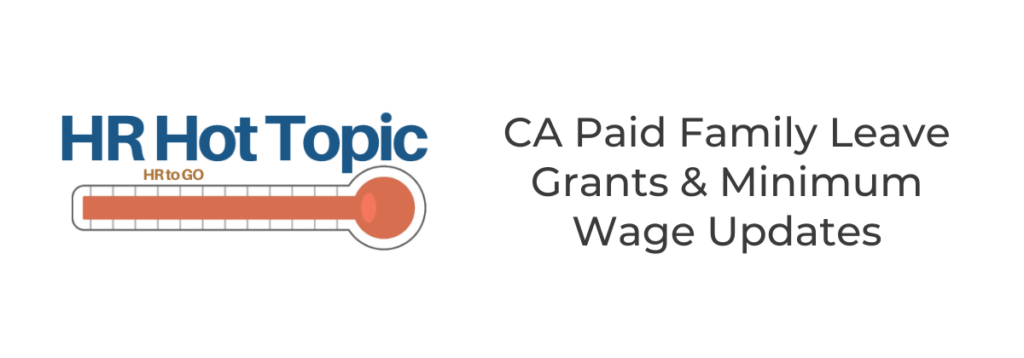

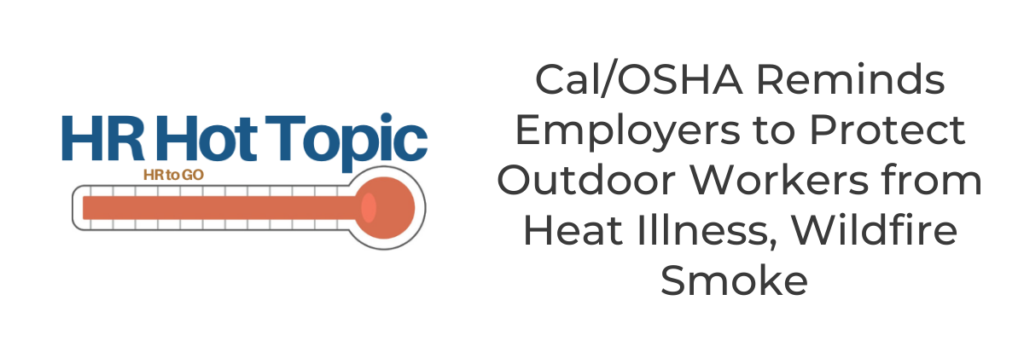
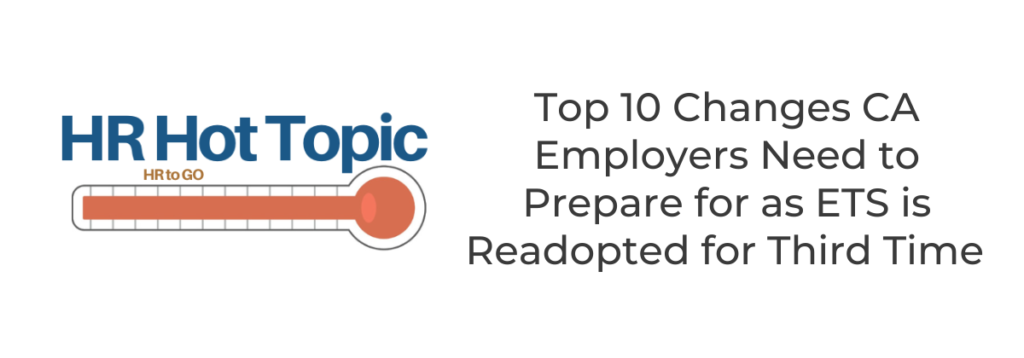
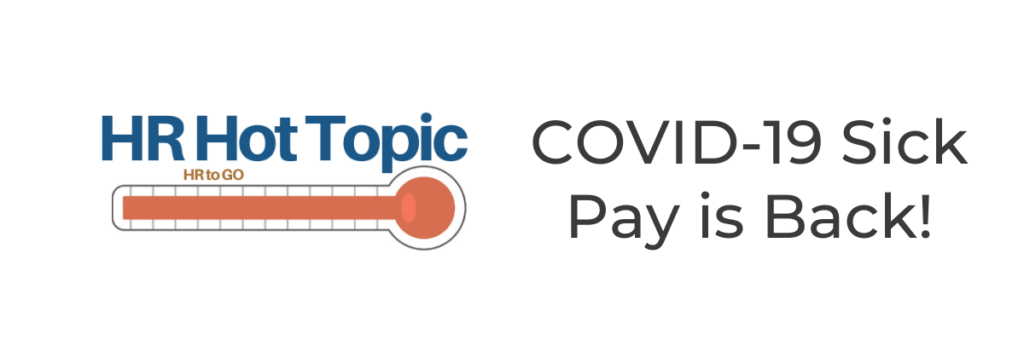
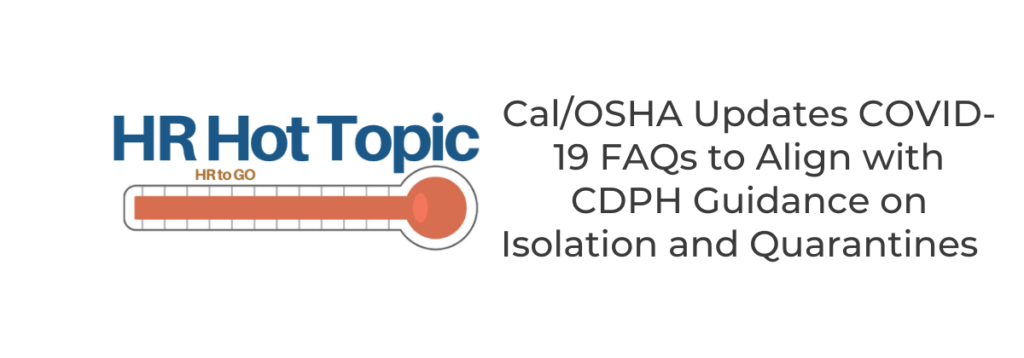
HR Hot Topic – COVID-19 Paid Sick Leave Extended Through End of the Year & Pay Transparency Act
COVID-19 Paid Sick Leave (SPSL) Extended Through End of the Year
As anticipated from last week’s newsletter, on September 29, 2022, Governor Gavin Newsom signed AB 152 into law. AB 152 is a budget trailer bill extending an employee’s eligibility to use 2022 COVID-19 Supplemental Paid Sick Leave (SPSL) through December 31, 2022. SPSL applies to employers with 26 or more employees.
Update (October 3): The California Division of Labor Standards Enforcement (DLSE) has updated the SPSL poster to reflect the new expiration date. Employers should replace their existing posters with this version and may send the poster via email to employees who are completely remote.
When California initially enacted the 2022 COVID-19 SPSL program, employees were provided up to 40 hours of paid sick leave for the following seven qualifying reasons:
In addition, an employee could receive up to 40 additional hours of paid sick leave if their qualifying reason for leave related to the employee or a qualifying family member contracting COVID-19. SPSL was originally set to expire on September 30, 2022.
Although AB 152 does extend the availability of SPSL through December 31, 2022, it doesn’t increase an employee’s leave entitlement. This means that if an employee has already used all their SPSL hours earlier this year, they don’t receive any additional hours. The California DLSE keeps an updated guidance resource for employers with further FAQs about administering SPSL.
Fortunately, California small businesses have some good news because AB 152 establishes a grant program to allow small businesses to recover up to $50,000 paid out in SPSL benefits over the course of the year. The grant program will be administered through the Office of the Small Business Advocate (OSBA) within the Governor’s Office of Business and Economic Development (GO-Biz). Although GO-Biz and OSBA have not yet established the application process, AB 152 does establish criteria that can help small businesses prepare to apply as soon as the application period is open.
The grant is available to qualifying small businesses and non-profits. To qualify, the organization must:
Some organizations that do meet the criteria above are excluded from the grant program. The exclusion includes organizations without a physical presence in the state, engaged primarily in political or lobbying activities, and financial institutions that primarily lend money.
While GO-BIZ and OSBA prepare to get the program up and running, employers that do meet the above criteria can begin to collect the information required to help expedite the process and take advantage of this grant program.
Show Me the Money: California Enacts New Pay Disclosure Requirements
Pay transparency laws have gathered steam across the country. California follows Colorado, Connecticut, Maryland, Nevada, Rhode Island, Washington, New York City, Cincinnati, and Toledo, among other jurisdictions, in enacting legislation to require employers to disclose wage information to job applicants, and in some instances, to current employees. Advocates of the new law assert that it will help drive pay equity across genders and nationalities. After intense floor hearings in the state assembly and senate, and five major amendments, on September 27, 2022, Governor Newsom signed Senate Bill 1162, which goes into effect on January 1, 2023.
This sweeping new law imposes two significant requirements on covered employers: job-posting requirements and pay data disclosures. The law requires employers with 15 or more employees to include a pay scale in job postings starting January 1, 2023. Companies with 100 or more employees must report to the state the pay data of their employees and contractors by race, ethnicity and gender.
Pay Scale Disclosures
Job postings. Both private and public employers must follow the new wage disclosure requirements for job postings. This requirement is meant to address wage disparities at the beginning of employment. Newly revised Labor Code section 432.3 applies to employers with 15 or more employees. Covered employers are required to include a pay scale for the job opening being advertised. This includes third-party postings used by employers. The pay scale must be given to the third party so they can include it in their job advertisement for the employer. The law does not address whether nationwide job postings must comply if the opening could be filled by someone in California.
The definition of pay scale in this law is broad and open to interpretation. Pay scale is defined as the salary or hourly wage range that the employer reasonably expects to pay for the position. It is unclear whether this includes bonuses, commissions, health benefits or paid time off. Those variable factors could make a big difference in the amount disclosed.
Pay scale requests. All covered employers must now provide current employees with a pay scale for their position upon request. Many employers will see an onslaught of requests from current employees after the new year, so employers should prepare now for those conversations.
A portion of existing law was quietly stricken as a result of this bill. Prior to enactment of SB1162, applicants for employment were already entitled to request the pay for an open position, but only if they had completed an initial interview with the employer. Now any applicant is entitled to this information upon reasonable request, without having to interview. An applicant is defined as someone who is “seeking employment with the employer and is not currently employed with that employer in any capacity or position.” The law does not differentiate between job seekers in general and someone who has submitted an application.
Record retention. Under the law, employers must abide by new record retention requirements. Covered employers must maintain a record of each employee’s job title and wage history during their employment period and for three years thereafter. These records must be made available to the Labor Commissioner for inspection to determine if there is a pattern of wage discrepancy. An employer’s failure to keep these records creates a rebuttable presumption in favor of an employee’s claim. This is a burdensome recordkeeping requirement and imposes an obligation to save records well beyond any current record retention schedule. As a result, employers should plan how to save older records before they are purged and revise any existing retention schedules to comply with SB 1162.
Enforcement. The law establishes a new private right of action for injunctive and other relief. There are also civil penalties for violations of this statute. A person can file a written complaint with the Labor Commissioner within one year from the date they learned of the violation (not when the violation may have occurred.) Technical violations of the new pay scale requirements could lead to penalties up to $10,000 per violation. The first penalty will not be assessed if the employer has demonstrated they have cured the job posting violation by updating it to include the pay scale.
Annual Pay Data Report
This new law significantly amends the Annual Pay Data Report requirements. Private employers with 100 or more employees must file an annual report with the Civil Rights Department that discloses certain pay data according to race, ethnicity, and gender within each of the following job categories:
The following information must be disclosed in the Annual Pay Data Report:
Staffing companies are included. Private employers with 100 or more employees hired through labor contractors in the prior calendar year must submit a separate pay data report covering labor contractors. The law defines a labor contractor as “an individual or entity that supplies, either with or without a contract, a client employer with workers to perform labor within the client employer’s usual course of business.” The legislature included staffing companies and labor contractors in this bill under the assumption that use of contractors is on the rise, and that contract workers provide the same services as directly hired employees but are paid less. As a result, SB1162 also requires the gathering and reporting of data for this category of workers.
Covered employers must now disclose the ownership names of all labor contractors used to supply workers. Only one sentence in the law addresses this requirement: “A labor contractor shall supply all necessary pay data to the private employer.” If an employer is unable to submit a “complete and accurate report” because the staffing company failed to provide its pay data to the employer, the Civil Rights Department may ask a court to apportion an appropriate portion of penalties against the labor contractor.
Filing Deadline. The first report is due May 10, 2023, and annually thereafter on the second Wednesday in May. The Department must be able to review and sort the categories of information provided. Employers must upload their data files using the California Pay Data Reporting Portal.
Penalties May Be Imposed and Costs Recovered. Failure to file the report can lead to civil penalties of $100 per employee for the first offense and $200 per employee for subsequent violations. For an employer with 100 employees, that could amount to a $10,000 fine. Larger corporations with several hundred employees in multiple establishments are looking at far more significant fines. The law authorizes the Department to recover the costs of compelling an employer to comply with the reporting requirements.
Enforcement. The law also authorizes the Civil Rights Department to request the Employment Development Department to provide it with the names and addresses of all businesses with 100 or more employees to ensure each complies with the report filing requirements. This list, while meant for auditing purposes, will be a public record. We anticipate that the Civil Rights Department will enact regulations in the next year with further details of disclosure and compliance obligations.
California public and private employers should begin preparing now for these significant new legal requirements.
Sources: COVID-19 Paid Sick Leave (SPSL) Extended Through End of the Year: https://hrwatchdog.calchamber.com/2022/09/covid-19-paid-sick-leave-spsl-extended-through-end-of-the-year/
Show Me the Money: California Enacts New Pay Disclosure Requirements: https://www.littler.com/publication-press/publication/show-me-money-california-enacts-new-pay-disclosure-requirements